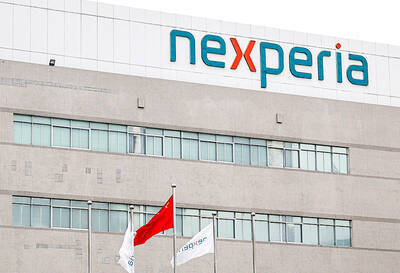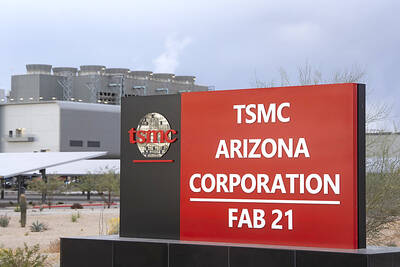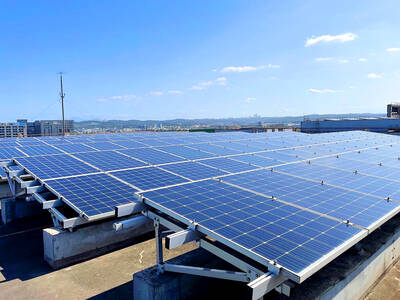The nation’s two biggest LCD panel makers, AU Optronics Corp (AUO, 友達) and Innolux Corp (群創), on Wednesday reported that their second-quarter net profits were the strongest quarterly figures in more than seven years, benefiting from the industry’s longest boom cycle amid a supply crunch.
The companies expressed confidence about the third quarter, despite recent price corrections.
The prolonged boom has boosted prices of flat panels and TVs, which only sidelined consumer purchasing and dampened TV sales briefly, the firms said.
Recent price reductions are to serve as a catalyst for robust TV sales during the peak season, which begins this quarter, AUO and Innolux executives said.
“Customers are building inventories for the high season,” AUO chairman and chief executive officer Paul Peng (彭双浪) told an investors’ teleconference. “We believe business is coming back after brief turbulence.”
“The third quarter should be a strong season. TV vendors are stepping up sales promotions to reach whole-year sales targets and taking advantage of recent price adjustments,” Peng said.
Growth drivers are mainly to come from cathode ray tube TV replacement demand in emerging markets, including Asia, Latin America and Russia, AUO said.
AUO said it is not worried about a potential risk of oversupply, with several new Chinese plants to begin mass production later this year.
“Based on our calculations, additional supply from China will only add 3 percent capacity to the market, which is not sufficient to tilt the supply-demand balance,” Peng said.
This year is to be a healthy one for the LCD industry, as global panel demand is expected to outgrow supply by about 2 percent, AUO said.
Meanwhile, Innolux downplayed potential effects from China, where the world’s first 10.5G fab is to begin mass production next year.
“We do not expect oversupply to happen in all segments next year, despite overall supply growth expected to be significant,” Innolux chairman Wang Jyh-chao (王志超) said at a separate teleconference.
“Chinese panel makers might only produce mid to low-end panels using that new, advanced factory due to high technological barriers,” Wang said.
The firms might be immune to the effects, as they focus on making high-end panels for TVs with narrow bezels and rich color performance, they said.
In the quarter ended June 30, AUO’s net profit rose 3.7 percent to NT$9.83 billion (US$324.94 million), compared with NT$9.48 billion in the first quarter, which was a nine-year high.
Shipments of TV and PC panels are expected to be flat, or rise slightly, this quarter from last quarter, AUO said.
Average selling prices are expected to be little changed on a quarterly basis, it said.
TV panel shipments are expected to rise by a low single-digit percentage this quarter, while average selling price is expected to fall by a low single-digit percentage, Innolux said.
Innolux’s net profit last quarter rose to a seven-year high of NT$12.12 billion, up 2.2 percent from NT$11.86 billion in the first quarter.

JITTERS: Nexperia has a 20 percent market share for chips powering simpler features such as window controls, and changing supply chains could take years European carmakers are looking into ways to scratch components made with parts from China, spooked by deepening geopolitical spats playing out through chipmaker Nexperia BV and Beijing’s export controls on rare earths. To protect operations from trade ructions, several automakers are pushing major suppliers to find permanent alternatives to Chinese semiconductors, people familiar with the matter said. The industry is considering broader changes to its supply chain to adapt to shifting geopolitics, Europe’s main suppliers lobby CLEPA head Matthias Zink said. “We had some indications already — questions like: ‘How can you supply me without this dependency on China?’” Zink, who also

Taiwan Semiconductor Manufacturing Co (TSMC, 台積電) received about NT$147 billion (US$4.71 billion) in subsidies from the US, Japanese, German and Chinese governments over the past two years for its global expansion. Financial data compiled by the world’s largest contract chipmaker showed the company secured NT$4.77 billion in subsidies from the governments in the third quarter, bringing the total for the first three quarters of the year to about NT$71.9 billion. Along with the NT$75.16 billion in financial aid TSMC received last year, the chipmaker obtained NT$147 billion in subsidies in almost two years, the data showed. The subsidies received by its subsidiaries —

At least US$50 million for the freedom of an Emirati sheikh: That is the king’s ransom paid two weeks ago to militants linked to al-Qaeda who are pushing to topple the Malian government and impose Islamic law. Alongside a crippling fuel blockade, the Group for the Support of Islam and Muslims (JNIM) has made kidnapping wealthy foreigners for a ransom a pillar of its strategy of “economic jihad.” Its goal: Oust the junta, which has struggled to contain Mali’s decade-long insurgency since taking power following back-to-back coups in 2020 and 2021, by scaring away investors and paralyzing the west African country’s economy.

RE100 INITIATIVE: Exporters need sufficient supplies of renewable energy to meet their global commitments and remain competitive, the economics ministry said Local export-oriented manufacturers, including Taiwan Semiconductor Manufacturing Co (台積電), require sufficient supplies of green energy to maintain their competitiveness and regulations already ensure that renewable energy development adheres to environmental protection principles, the Ministry of Economic Affairs said yesterday, as the legislature imposed further restrictions on solar panel installations. The opposition-led Legislative Yuan yesterday passed third readings to proposed amendments to three acts — the Environmental Impact Assessment Act (環境影響評估法), the Act for the Development of Tourism (發展觀光條例) and the Geology Act (地質法) — which would largely prohibit the construction of solar panels in some areas. The amendments stipulate that ground-mounted solar